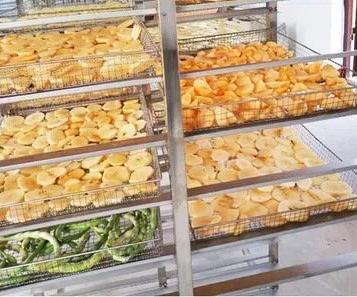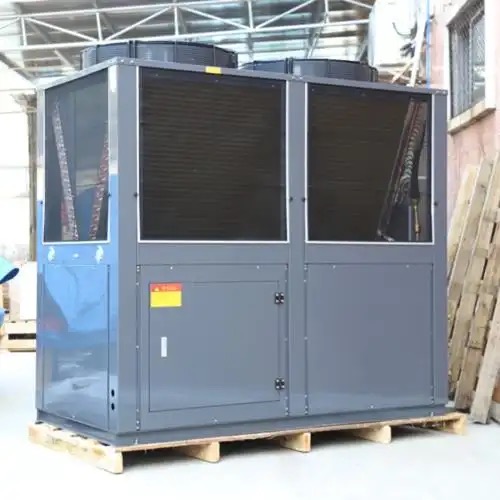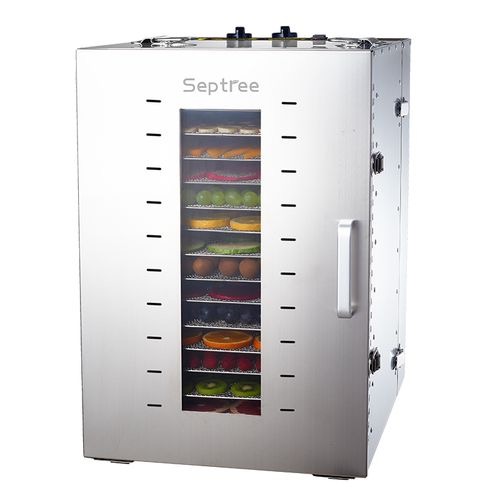
Content Menu
● Introduction
● What Is a Food Dryer?
>> Types of Food Dryers
● What Is a Condenser Dryer vs Heat Pump?
>> Condenser Dryer
>>> Advantages of Condenser Dryers
>>> Disadvantages of Condenser Dryers
>> Heat Pump Dryer
>>> Advantages of Heat Pump Dryers
>>> Disadvantages of Heat Pump Dryers
>> Comparison Table
● Choosing Between Condenser and Heat Pump Dryers
● Applications of Food Dryers
>> Popular Foods Dried Using Food Dryers
● Maintenance Tips for Food Dryers
>> Troubleshooting Common Issues
● Innovations in Food Drying Technology
● Conclusion
● Related Questions
>> 1. What foods are best suited for drying with a heat pump dryer?
>> 2. How does energy efficiency impact operating costs?
>> 3. Can I use both types of dryers interchangeably?
>> 4. What maintenance is required for these dryers?
>> 5. Are there any safety concerns with using food dryers?
Introduction
In the world of food processing, drying is a crucial method for preserving food, enhancing flavors, and extending shelf life. Among the various technologies available, food dryers are essential tools that come in different types, including condenser dryers and heat pump dryers. This article will explore these two types of food dryers, their functionalities, benefits, and how they compare against each other.

What Is a Food Dryer?
A food dryer is an appliance that removes moisture from food items to inhibit the growth of bacteria, yeasts, and molds. By reducing the water content, dried foods can be stored for longer periods without refrigeration. Food drying is commonly used for fruits, vegetables, meats, and herbs.
Types of Food Dryers
Food dryers can be categorized into several types based on their drying mechanisms:
- Condenser Dryers: These dryers work by using a heat source to evaporate moisture from the food. The moisture-laden air is then cooled down in a condenser unit, where it transforms back into liquid form and is collected.
- Heat Pump Dryers: Heat pump dryers utilize a refrigeration cycle to extract moisture from food. They are known for their energy efficiency and ability to operate at lower temperatures while maintaining high-quality drying results.
What Is a Condenser Dryer vs Heat Pump?
When considering food drying technologies, understanding the differences between a condenser dryer and a heat pump dryer is essential.
Condenser Dryer
A condenser dryer uses heat to evaporate moisture from the food. The process involves:
1. Heating: The dryer heats the air that circulates around the food.
2. Evaporation: As the heated air passes over the food items, moisture evaporates into the air.
3. Condensation: The warm, moist air is then cooled in a condenser unit where the moisture condenses back into water and is collected.
Advantages of Condenser Dryers
- Simplicity: They are generally easier to operate and maintain.
- Cost-Effective: Initial investment costs are often lower than heat pump dryers.
- Quick Drying: They can achieve faster drying times under certain conditions.
Disadvantages of Condenser Dryers
- Energy Consumption: They may consume more energy compared to heat pump dryers.
- Higher Operating Temperatures: This can lead to potential quality loss in sensitive foods.
Heat Pump Dryer
Heat pump dryers operate using a closed-loop system that recycles air within the unit. The process includes:
1. Evaporation: Moisture is evaporated from the food using warm air.
2. Condensation: The moisture-laden air is passed through an evaporator where it cools down and condenses.
3. Recycling Heat: The heat extracted during condensation is reused to warm up incoming air.
Advantages of Heat Pump Dryers
- Energy Efficiency: They use significantly less energy due to their recycling mechanism.
- Low Operating Temperatures: Ideal for delicate foods that require gentle drying processes.
- Quality Preservation: Better retention of flavors and nutrients in dried foods.
Disadvantages of Heat Pump Dryers
- Higher Initial Costs: The upfront investment can be more significant than that of condenser dryers.
- Complexity: More components can lead to increased maintenance needs.
Comparison Table
| Feature | Condenser Dryer | Heat Pump Dryer |
| Energy Efficiency | Moderate | High |
| Initial Cost | Lower | Higher |
| Operating Temperature | Higher | Lower |
| Drying Time | Faster under certain conditions | Slower but more thorough |
| Quality Preservation | Moderate | High |
Choosing Between Condenser and Heat Pump Dryers
When selecting a dryer for your food processing needs, consider the following factors:
1. Type of Food: Delicate items like herbs or fruits may benefit more from heat pump technology due to lower temperatures.
2. Volume of Production: For larger operations requiring quick drying times, a condenser dryer might be more suitable.
3. Energy Costs: Evaluate local energy prices; heat pump dryers can save money in the long run despite higher initial costs.
4. Budget Constraints: Determine your budget for both initial investment and ongoing operational costs.
5. Space Availability: Ensure you have enough space for installation and maintenance access for your chosen dryer type.

Applications of Food Dryers
Food dryers are versatile appliances used across various industries:
- Agricultural Sector: Farmers use food dryers to preserve surplus produce during harvest seasons, minimizing waste and increasing profitability.
- Food Processing Industry: Manufacturers utilize dryers for creating snacks like dried fruits, jerky, and vegetable chips, catering to consumer demand for convenient and healthy options.
- Home Use: Many households invest in food dryers for personal use, enabling them to create homemade snacks while controlling ingredients and flavors.
Popular Foods Dried Using Food Dryers
Food dryers can effectively handle a wide range of products:
- Fruits: Apples, bananas, strawberries, and mangoes are popular choices due to their natural sweetness and flavor concentration when dried.
- Vegetables: Carrots, bell peppers, tomatoes, and zucchini can be dehydrated for use in soups or snacks.
- Meats: Jerky production has gained popularity as consumers seek high-protein snacks with minimal preservatives.
- Herbs and Spices: Basil, oregano, thyme, and other herbs retain their flavor well when dried properly.
Maintenance Tips for Food Dryers
Proper maintenance ensures longevity and optimal performance of your food dryer:
- Regularly clean filters and condensate trays.
- Inspect seals and gaskets for wear and tear.
- Schedule routine checks on electrical components and heating elements.
Troubleshooting Common Issues
Even with proper maintenance, issues may arise with food dryers:
1. Drying Inefficiency:
- Check if filters are clogged or if there's an issue with airflow.
- Ensure that the temperature settings are appropriate for the type of food being dried.
2. Unpleasant Odors:
- Clean the interior regularly to prevent residue buildup from previous batches.
- Use baking soda or vinegar solutions during cleaning cycles to neutralize odors.
3. Inconsistent Results:
- Make sure that foods are cut into uniform sizes to ensure even drying.
- Rotate trays if applicable to promote uniform airflow around all items.
Innovations in Food Drying Technology
As technology advances, so do food drying methods:
- Smart Technology Integration: Some modern food dryers come equipped with smart features allowing users to monitor drying progress via mobile apps or receive alerts when cycles are complete.
- Improved Energy Efficiency Standards: Newer models focus on sustainability by using advanced insulation materials that minimize energy consumption while maximizing performance.
- Multi-functional Units: Some appliances now combine drying with other cooking methods like steaming or vacuum sealing for enhanced versatility in food preparation.
Conclusion
Choosing between a condenser dryer and a heat pump dryer ultimately depends on your specific needs in food processing. While both types have their advantages and drawbacks, understanding how they operate will help you make an informed decision that aligns with your production goals. Whether you prioritize energy efficiency or initial cost savings, there's a suitable option available for every operation.
Investing in the right type of food dryer can significantly impact product quality while ensuring efficient processing practices. As consumer demand grows for dried foods—ranging from healthy snacks to convenient meal solutions—having reliable equipment becomes increasingly important for both commercial producers and home users alike.

Related Questions
1. What foods are best suited for drying with a heat pump dryer?
- Delicate fruits, vegetables, herbs, and meats benefit most from heat pump dryers due to low operating temperatures that preserve quality better than higher heat methods.
2. How does energy efficiency impact operating costs?
- Energy-efficient models like heat pump dryers typically lead to lower electricity bills over time despite higher initial costs due to reduced energy consumption during operation.
3. Can I use both types of dryers interchangeably?
- While both can dry food effectively, they may not yield the same quality or speed; it's best to choose based on specific needs related to product type and desired outcomes.
4. What maintenance is required for these dryers?
- Regular cleaning of filters is essential; checking seals periodically helps maintain efficiency while inspecting electrical components ensures safety during operation.
5. Are there any safety concerns with using food dryers?
- Always follow manufacturer guidelines regarding temperature settings; ensure proper ventilation during operation to avoid overheating or fire hazards associated with high temperatures in confined spaces.












